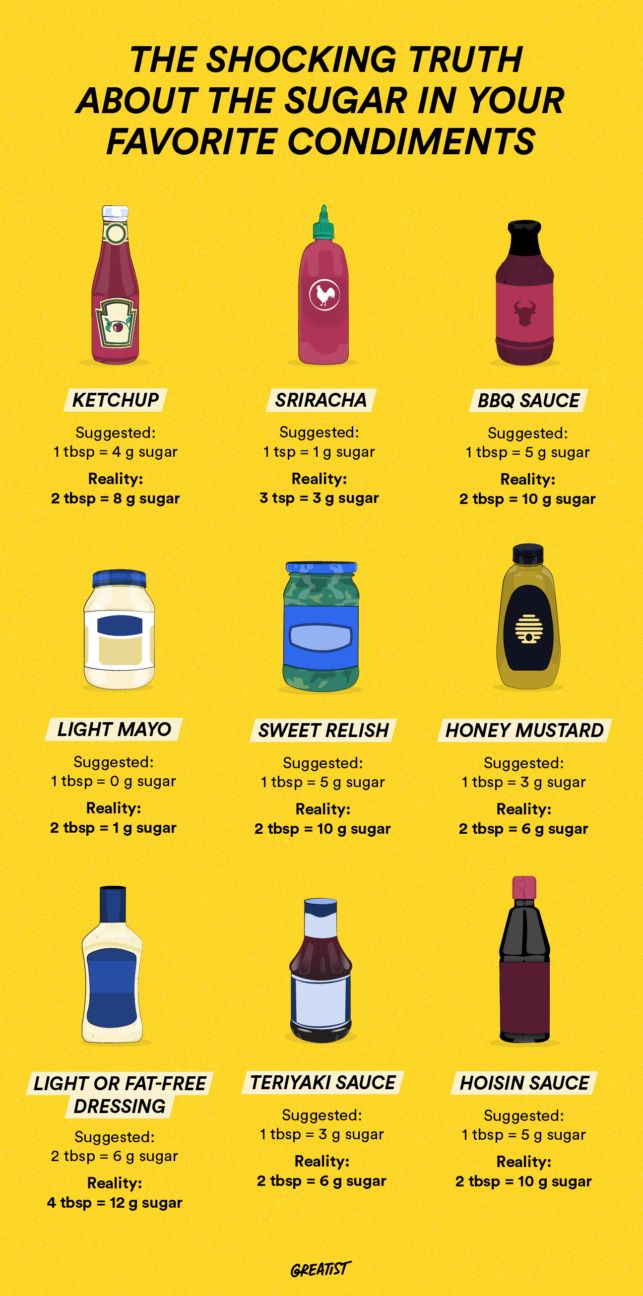Ever picked teriyaki chicken over General Tso’s and prided yourself on resisting the fried option?
Nixed the oil-based vinaigrette on your salad for a “lite” poppyseed dressing?
Liberally spread your sandwiches with honey mustard instead of mayo?

Before patting yourself on the back for choosing what you think is the healthier condiment, take a minute to consider that the alternative may have saved you grams of fat, but it filled that void with another ingredient: sugar, and lots of it.
So many bottled condiments are loaded with sugar. Going by many pseudonyms — such as high-fructose corn syrup, molasses, and cane syrup — sugar sneaks into the most unexpected dipping sauces, spreads, and dressings.
It’s high time to get savvier about the sugar we’ve unknowingly been adding to our food. We broke down nine condiments that pack a surprising amount of the sweet stuff.
Since we think there’s a difference between the suggested serving size and how much we’re really layering on, we broke it down by comparing suggested servings versus reality.
We also rounded up from the figures in the U.S. Department of Agriculture’s (USDA) FoodData Central sugar measurement for food. We can’t account for all brands, but where we could, we used data from the generic product and rounded up to the nearest whole number. (Given how processed many store-bought condiments can be, it’s safe to assume any product is more sugary than you suspected.)
And don’t miss our tips for keeping your consumption in check so your condiments aren’t hampering your eat-less-sugar goals.
1. Ketchup
A standard ketchup bottle will tell you one serving is a tablespoon and packs 4 grams of sugar (the USDA lists generic ketchup as having 3.19 grams of sugar per tablespoon).
But who really consumes a measly tablespoon with their basket of fries or grilled cheese? That’s right — literally nobody.
We’re all easily putting away at least two servings of the stuff each time we use it, so if we’re being realistic, we’re eating a minimum of 2 tablespoons — that’s about 8 grams of sugar.
Sugar per serving
Suggested: 1 tbsp = 4 g sugar
Reality: 2 tbsp = 8 g sugar
2. Sriracha
Finding out sugar is listed second on the ingredient list behind that iconic rooster logo is a heartbreaking moment. Why couldn’t sriracha be saved? We thought it had our backs, then bam! Right in the betrayal.
The USDA lists sriracha as having 0.982 grams of sugar per teaspoon (so let’s call it 1 gram). But who was the last hot sauce lover you saw using a teaspoon to measure out their serving? Come on.
So yeah, that’s not realistic either.
Sugar per serving
Suggested: 1 tsp = 1 g sugar
Reality: 3 tsp = 3 g sugar
3. Barbecue sauce
Sugar content in barbecue sauce varies based on the brand. But no matter what kind you’re using, it’s a pretty good bet that it’ll have at least 4.65 grams of the sweet stuff per 1-tablespoon (about 14-gram) serving in the form of sugar, high fructose corn syrup, and/or molasses.
(We’re calling that 5 grams of sugar, and to be honest, many brands of barbecue sauce have at least 6 grams.)
But when did you last use less than 1/4 cup of barbecue sauce to baste a chicken breast, marinate a steak, or slow-cook pulled pork? We’ll wait. That basting takes a lot of tablespoons — and a lot of sugar.
Hot diggity dang, is it tasty, though.
Sugar per serving
Suggested: 1 tbsp = 5 g sugar
Reality: 2 tbsp = 10 g sugar
4. Mayonnaise
Most mayos proudly claim they contain zero grams of sugar per serving, but the ingredients clearly show sugar is involved. What gives?!
Annoyingly enough, according to food-labeling laws, a product can be advertised as having no sugar if it contains less than 0.5 grams per serving. Um… that’s still sugar, folks. Sorry to break it to you.
Regardless, if you’re adding regular mayonnaise, sugar isn’t the problem so much as fat content. The “light” varieties substitute sugars for fats to retain flavor, so they have more stealth sugars.
(The USDA lists one 15.6-ounce tablespoon of light mayonnaise as having 0.55 grams of sugars, which is definitely more than 0.5 grams. Step up your mayonnaise labeling game, world.)
While mayo manufacturers aren’t technically breaking the rules, they’re still being sorta sneaky, especially for anyone who’s avoiding all the sugars.
So if you’re adding more than a tablespoon (chicken salad, anyone?), you’re adding at least 1 gram of sugar (unless you’re using these recipes). No, it’s not the end of the world, but it can sneak up on you.
Sugar per serving
Suggested: 1 tbsp = 0 g sugar
Reality: 2 tbsp = 1 g sugar
5. Sweet relish
Given its name, it’s no surprise sweet relish is a sugar-laden condiment.
A 1-tablespoon serving comes with a hefty 4.37 grams of it, according to the USDA (we’ll call that 5 grams for the sake of helping you cut sugars).
This is often due to high fructose corn syrup — something to consider before you start dolloping generous spoonfuls of relish onto your hot dog.
Then again, if you’re eating a hot dog, you probably aren’t in prime “tracking added sugars and processed ingredients” mode.
Sugar per serving
Suggested: 1 tbsp = 5 g sugar
Reality: 2 tbsp = 10 g sugar
6. Honey mustard
Many people choose honey mustard as a lower-fat alternative to mayo and think it’s perfectly healthy because, you know, there are antioxidants in honey.
So it might come as a shock that in most commercial brands, honey is listed way down on the ingredient list, well after both high fructose corn syrup and sugar. 😱 Egads!
Sugar counts can creep up to 3 grams per tablespoon (the USDA says 2.47 grams for generic honey mustard), meaning this condiment easily packs at least 6 grams of sugar when you smother your meal with the sweet stuff.
Sugar per serving
Suggested: 1 tbsp = 3 g sugar
Reality: 2 tbsp = 6 g sugar
7. Light or fat-free dressing
Many light or fat-free dressings pile on the sugar (plus other hard-to-pronounce ingredients) in an effort to replace the flavor and consistency that the missing fat would offer.
Light or fat-free dressings can have 3 (ranch), 5 (raspberry vinaigrette, poppyseed), or even 6 (Thousand Island) grams of sugar per 2-tablespoon serving.
Reality dictates that you can easily double or triple that when you’re drizzling it onto your salad or sandwich — especially if the dressing comes pre-poured on a restaurant dish.
Sugar per serving
Suggested: 2 tbsp = 6 g sugar
Reality: 4 tbsp = 12 g sugar
8. Teriyaki sauce
Bottled teriyaki sauces use plain sugar, cane syrup, or high fructose corn syrup to get that sweet flavor that cuts the saltiness from the soy.
Depending on which brand you use, you could be putting away 2 to 7 grams of sugar per tablespoon. Yikes. The USDA puts the sugar content of an 18-gram tablespoon of generic, ready-to-serve teriyaki sauce at 2.54 grams. We’ll call it 3 grams, but that’s conservative — some brands of teriyaki sauce can be a lot more sugary.
If your local takeout restaurant is using bottled sauce to make your favorite teriyaki dinner, you can bet it’s using more than a tablespoon at a time (that’s why it tastes so good).
Sugar per serving
Suggested: 1 tbsp = 3 g sugar
Reality: 2 tbsp = 6 g sugar
9. Hoisin sauce
A popular condiment for meat and stir-fries, hoisin sauce is also a land mine when it comes to sugar content.
Sugar appears first or second on most bottled versions’ ingredient lists, which explains why a single tablespoon can easily contain 9 or 10 grams. Yikes.
The USDA lists a 1-tablespoon serving of hoisin as having 4.91 grams of sugar, so we’ll let hoisin off with 5 grams per tablespoon. But just know that many brands hit a higher mark.
Sugar per serving
Suggested: 1 tbsp = 5 g sugar
Reality: 2 tbsp = 10 g sugar
Now that you’re clued in to how much sugar could be hiding in those bottles, rest assured that you don’t necessarily have to eliminate these condiments entirely (that would be a sad, sad existence). We’d never ask that of you.
Instead, just being aware of the contents of your condiments can be enough to make you choosier about when you use them.
For example, if you’re enjoying a rare afternoon at a ball game and want a burger with relish, go for it. But you may want to think twice about that sizable “drizzle” of ranch on your daily salad.
You can also choose healthier alternatives that keep sugar to a minimum.
Here are some more tips for keeping those sugary condiments to a reasonable minimum.
1. Keep an eye on quantity
Most condiments have a serving size of 1 or 2 tablespoons. If you don’t want to give them up, try sticking to those portions.
Eyeballing serving sizes can be one way to keep yourself in check. Think of a tablespoon as roughly the size of your thumb tip and use that as a guide when squeezing out your condiment of choice.
It takes a bit of practice, but it’s better (and more realistic) than toting around a measuring spoon for every meal.
2. Find less-sweet swaps
Explore other ways to flavor your food that replace or at least cut down on the sugar-laden condiments. Some recommendations, for starters:
- Dijon mustard has a nice kick that you’ll never get from honey mustard.
- Salsa (check the ingredients for added sugar) can be a fun way to top salads.
- Slather your sandwich with hummus instead of mayo.
- Herbs and spices, such as cinnamon, can provide subtle, complex natural sweetness without any sugar at all.
There are plenty of no-sugar alternatives out there, and experimenting with them can make you feel more like you’re adding to your options instead of taking away from them.
3. DIY it!
If you’re feeling crafty, make your own lower-sugar versions of your favorite condiments — especially if you know you’re going to be using more than a single serving at a time.
Most homemade condiment recipes are actually pretty simple, use whole-food ingredients, and contain little to no added sugar.
For example, try this roasted red pepper dip that literally takes 5 minutes.
You don’t have to punish yourself or make food bland and lifeless by skipping the sauce.
Instead, just think about how much sugar condiments might be adding to your food and either use less or make your own. That way, you can keep tabs on the sugar.
Here’s how to make 37 healthy dressings, marinades, and spreads, so you can up your homemade condiment game and add flavor to your food.


